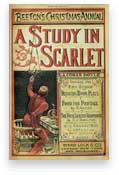School board removes A Study in Scarlet
 The school board of Albermarle County in Virginia has removed A Study in Scarlet from a reading list because of the book’s portrayal of the Mormon religion. Now note that they’re not removing the book from the library but simply saying it’s inappropriate for a sixth-grade reading list.
The school board of Albermarle County in Virginia has removed A Study in Scarlet from a reading list because of the book’s portrayal of the Mormon religion. Now note that they’re not removing the book from the library but simply saying it’s inappropriate for a sixth-grade reading list.
I don’t want to go too much into Arthur Conan Doyle’s representation of the Mormon faith at the time of the novel (or actually the time of the flashback in the book), but for those unfamiliar with the story, it involves John Ferrier and his daughter Lucy, who were saved from dying in the desert by the Mormons on the condition they adopt the Mormon faith. Ferrier agrees and he arrives with the Mormon in what is to be Salt Lake City in Utah. Ferrier is very successful and rises to prominence, but he refuses to marry his daughter to any of her prospective suitors because he privately loathes the Mormon faith. Moreover his daughter has fallen for Jefferson Hope, a non Mormon, who has promised Ferrier that he will lead them all to safety.
But Hope is unable to rescue them. Ferrier is killed and his daughter dies from despair after her marriage to one of the suitors. Hope flees America and in Doyle’s story is working as a cabbie in London when he recognizes the two men who led to his beloved’s death. Their deaths draws Holmes and Watson into the case.
The story has been criticized for its heavy-handed portrayal of the Mormon faith and the savagery of the “Avenging Angels” or Danites who enforced the will of the faith. Although it is true that there are atrocities attributed to the faith, that can be said of many religions including Christianity. The United States even went to war of sorts with Utah over the Mountain Meadows Massacre. So I think Doyle is mostly guilty of overly dramatizing and creating from whole cloth a fictional event, but I should point out that’s what a novelist is supposed to do.
But I have other reasons disassociated with the portrayal of The Church of Jesus Christ of Latter-day Saints to dislike A Study in Scarlet and to think it a good idea not to include the story in a reading list. I know my reasoning is heresy because after all, Holmes and Watson are born in A Study in Scarlet. It contains the immortal “You have been in Afghanistan, I perceive.” And it contains our introduction to the world of 221B Baker Street and the first mention of the sallow rat-faced Lestrade.
Of course many other Holmes trappings are not included in the book: the jack-knifed correspondence and the tobacco in the Persian slipper. In fact the word shag doesn’t even come up in a search of the text. The book actually has a great deal of misinformation, if we believe that Holmes was deliberately misleading Watson, based on Watson’s list: SHERLOCK HOLMES—his limits.
But the most damning thing about STUD as an introduction to the great detective is that he’s missing from about a third of the book, which is a common — in my mind — failing of the Holmes novels. Doyle, as we know, was really a frustrated writer of great historical novels and it is perhaps understandable that he wanted to include some historical accounts into the Holmes stories. But of the 43,600 some odd words of the story, 15,000 of them are the flashback of Jefferson Hope. And I’ll admit when I first read them, it was a pretty gripping story, however accurate/inaccurate it may be. But even the first time I read them, I recall thinking, “When do we get back to Holmes and Watson?” Of course A Study in Scarlet has stood the test of time as a great Holmes story, however much I complain there’s just not enough Holmes in it.
The other novels, as I mentioned above, also have relatively little Holmes, with the worst offender being The Valley of Fear and the protracted Molly Maguires inspired flashback in Pennsylvania. It’s not one of my favorites with an almost 30,000-word flashback in an almost 58,000-word book. Much better is The Sign of the Four, which I might recommend as a suitable replacement on the reading list. The school board picked The Hound of the Baskervilles as the replacement and I cannot fault the choice, but I think The Sign of the Four, with the creepy Andaman islander Tonga (we hear little from the Andaman Island lobby), the exciting river chase and the dog Toby is a much better story as an introduction to Holmes. However I can realize that Holmes’ cocaine addiction in the story makes it unsuitable for inclusion in a sixth-grade reading list.
To a more mature reader, however, I would recommend The Sign of the Four as their introduction to Holmes. It’s similarly a fast story, just 43,500 words, of which only 8,800 are dedicated to Jonathan Small’s flashback, although it does make for a very long chapter, and it also introduces the future Mrs. Watson, who will complicate the relationship between Holmes and Watson. And unlike The Hound of the Baskervilles, Holmes doesn’t place his client’s life in danger, as he is often wont to do.
So if you have another candidate for the best introduction to Holmes, I’d love to hear it. If short stories were to be allowed, I’d undoubtedly pick The Adventure of the Red-Headed League, as I would pick The Adventures of Sherlock Holmes if collections were allowed.
